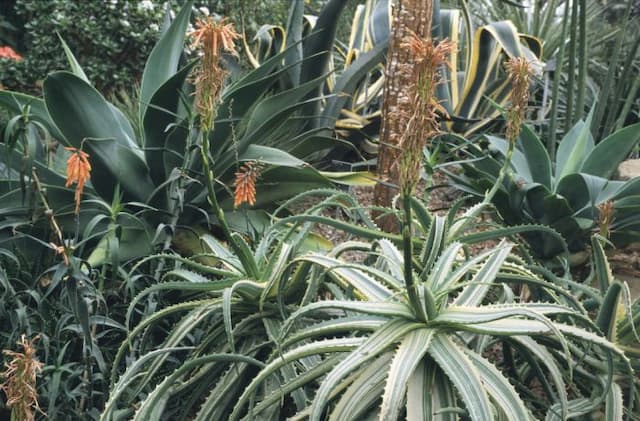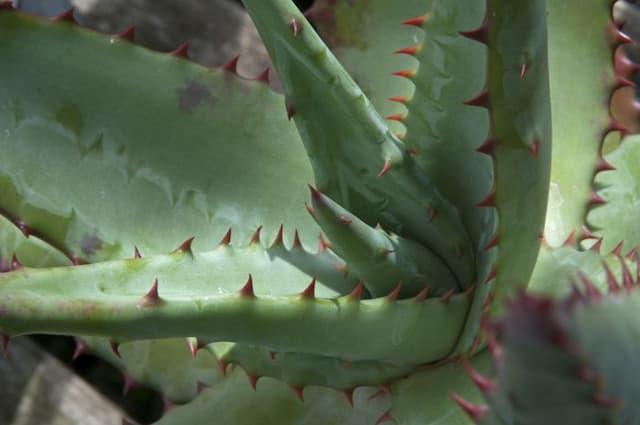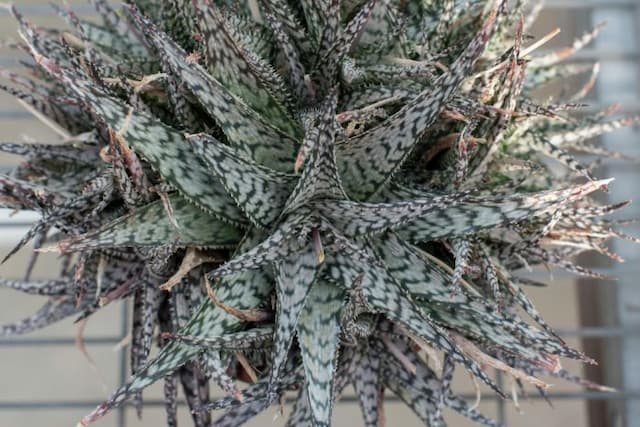Foxtail Lily Eremurus himalaicus

ABOUT
Eremurus himalaicus, commonly known as the Himalayan Foxtail Lily, is a striking perennial plant renowned for its unique floral display and structure. It showcases a long, towering spire-like arrangement of flowers that bloom from the bottom upwards. The blossoms are delicate and tubular, typically found in soft shades of white through to creamy hues, giving it an ethereal appearance akin to a densely packed bottlebrush. The leaves of the Himalayan Foxtail Lily are basal, meaning they grow at the base of the plant in a rosette pattern. They are long, narrow, and strap-like, with a slightly arching habit, presenting a soft green color that complements the bloom's tower. These leaves generally wither away before the flowering stalk is at its full glory, placing all attention on the spectacular tower of flowers. Roots of these plants are unique, consisting of a crown from which radiates numerous fleshy root structures, often referred to as tuberous roots. They serve as the storage organs for the plant, seeing it through harsh conditions and allowing it to burst forth with vigorous growth when conditions are favorable. When in bloom, the impressive flower spike is irresistible to pollinators such as bees and butterflies, providing an almost ladder-like structure for them to climb as they forage for nectar. After the flowering period, the plant produces seed pods that eventually crack open to disperse seeds, allowing for the possibility of new plants in the subsequent seasons. The overall appearance of the Himalayan Foxtail Lily is both architectural and graceful, making it a focal point when planted in a garden setting.
About this plant
 Names
NamesFamily
Asphodelaceae
Synonyms
Foxtail Lily, Desert Candle, Himalayan Desert Candle, Himalayan Foxtail Lily
Common names
Henningia himalaica, Eremurus spectabilis var. himalaicus
 Toxicity
ToxicityTo humans
Eremurus himalaicus, also known as Himalayan Foxtail Lily, does not have a widely recognized reputation for being toxic to humans. There is little to no information readily available that indicates the presence of toxic compounds in this plant that could cause poisoning if ingested. However, as with any plant, individual allergies or sensitivities could potentially cause adverse reactions, but such instances are not commonly reported with Eremurus himalaicus.
To pets
Himalayan Foxtail Lily is not commonly listed as a toxic plant for pets such as dogs and cats. There is a lack of substantial evidence indicating that ingestion of any part of the plant would result in poisoning or have harmful effects on pets. However, pet owners should always exercise caution and prevent their animals from eating plants, as individual reactions can vary and non-toxic plants could still cause gastrointestinal upset if ingested in large quantities.
 Characteristics
CharacteristicsLife cycle
Perennials
Foliage type
Deciduous
Color of leaves
Green
Flower color
White
Height
5 feet (1.5 meters)
Spread
2 feet (0.6 meters)
Plant type
Bulb
Hardiness zones
5
Native area
Himalayas
Benefits
 General Benefits
General Benefits- Ornamental Value: Eremurus himalaicus, commonly known as Foxtail Lily, adds aesthetic appeal to gardens with its tall spikes of flowers rising above the foliage.
- Drought Tolerance: Being a plant adapted to harsh environments, it has good drought resistance, requiring minimal watering once established.
- Attracts Pollinators: The Foxtail Lily attracts bees, butterflies, and other pollinators, which are important for the health of ecosystems and agricultural crops.
- Low Maintenance: It requires relatively low maintenance, making it suitable for gardeners who prefer plants that do not need constant care and attention.
- Architectural Structure: The plant provides strong visual interest and architectural structure to garden designs, especially when planted in groups.
- Seasonal Interest: Its flowering period in late spring to early summer offers seasonal interest in the garden when many other plants have yet to bloom.
- Perennial Growth: As a perennial, it re-grows every year, offering a long-term presence and reducing the need for annual replanting.
- Cold Resistance: Foxtail Lily is hardy in cold temperatures, which enables it to survive and thrive in a variety of climates.
- Versatility in Landscaping: It can be used in borders, mixed beds, and as a focal point in garden landscapes due to its height and impressive flowering spikes.
- Works as a Cutting Flower: Its tall flower stalks are ideal for use in cut flower arrangements, providing elegance and height to bouquets.
 Medical Properties
Medical Properties- This plant is not used for medical purposes.
 Air-purifying Qualities
Air-purifying QualitiesThis plant is not specifically known for air purifying qualities.
 Other Uses
Other Uses- The Eremurus himalaicus, also known as the Foxtail lily, can be used as a natural pest repellent in gardens due to its strong scent which some pests find unattractive.
- Its tall, dramatic spires make it a popular choice for vertical accent in landscape design, providing a sense of height and structure to garden compositions.
- The Foxtail lily can be used as a dye plant; its flowers may be harvested to create natural colorants for fabrics or yarns.
- Some cultures use the dried stalks of the Eremurus himalaicus in creating traditional musical instruments like wind chimes and flutes.
- The fibrous leaves and stems can be used in basket weaving, offering a unique material for artisanal crafts.
- The blossoms of the Foxtail lily are sometimes crystallized or candied for decorative edible purposes in high-end culinary presentations.
- Dried Eremurus himalaicus stalks can serve as organic support stakes for other plants in the garden, especially for climbers and vine plants.
- The plant has been used as a fodder alternative for livestock in regions where it’s prevalent and other fodder resources are scarce.
- Foxtail lily seeds have been used in botanical art and educational settings for plant morphology studies, due to their unique shape and size.
- During cultural festivals and ceremonies, the Eremurus himalaicus is used in floral arrangements to represent purity and attention due to its towering appearance and clean lines.
Interesting Facts
 Feng Shui
Feng ShuiThe Foxtail Lily is not used in Feng Shui practice.
 Zodiac Sign Compitability
Zodiac Sign CompitabilityThe Foxtail Lily is not used in astrology practice.
 Plant Symbolism
Plant Symbolism- Endurance and Survival: The foxtail lily, often found in harsh environments, symbolizes the ability to withstand difficult conditions and to endure through adversity.
- Majestic Beauty: With its tall, impressive spikes of flowers, the foxtail lily represents beauty that stands out and is admired by many.
- Resilience: The foxtail lily's ability to emerge strong and beautiful each year signifies resilience and the capacity to recover from challenges.
- Aspiration: The upward growth of the foxtail lily's flowers suggests reaching for one's goals and striving for improvement and higher achievements.
 Water
WaterThe Himalayan Foxtail Lily requires moderate watering, with a focus on keeping the soil consistently moist but not saturated during its active growth in spring and early summer. Water the plant with approximately 1 gallon of water per week, adjusting as necessary to account for rainfall or high temperatures. When the plant is dormant in late summer and fall, reduce watering to prevent rot. Be sure to water at the base of the plant to avoid wetting the foliage, which can promote disease.
 Light
LightThe Himalayan Foxtail Lily thrives best in full sun, receiving at least 6 to 8 hours of direct sunlight each day. They should be placed in a spot where they are primarily exposed to morning sunlight and have some protection from the harsh afternoon sun, especially in hotter climates, to prevent sunscald.
 Temperature
TemperatureThe Himalayan Foxtail Lily can withstand a temperature range from approximately 50°F to 80°F, with an ideal growing temperature around 60°F to 70°F. It is hardy and can survive brief periods of colder temperatures down to about 20°F, but it is important to protect the plant from prolonged freezing conditions.
 Pruning
PruningPruning the Himalayan Foxtail Lily is not typically necessary, but deadheading spent flowers after blooming will encourage healthier plants. Remove any dead or damaged foliage at the end of the growing season to maintain plant hygiene and reduce the risk of disease. The best time for this limited pruning is in late summer or early fall, after the plant has finished flowering.
 Cleaning
CleaningAs needed
 Soil
SoilThe ideal soil mix for Eremurus himalaicus, commonly known as Foxtail Lily, should be well-draining, fertile, with a good proportion of sand or grit to avoid water-logging. The plant thrives in a slightly alkaline to neutral pH range, ideally between 6.0 and 7.5. A mix of two-thirds soil and one-third sand or grit can work well for Foxtail Lilies.
 Repotting
RepottingFoxtail Lilies typically do not require frequent repotting as they are perennials that grow from tuberous roots. They can be left undisturbed for several years until the clumps become overcrowded. It's advised to repot or divide the plants every 3-5 years during their dormancy period to maintain vigor.
 Humidity & Misting
Humidity & MistingFoxtail Lily, or Eremurus himalaicus, prefers a dry atmosphere and does not require high humidity levels. They are well-suited for arid conditions typical of their native mountainous habitats. The best humidity level for this plant is low to moderate, avoiding excessive moisture which could lead to rot.
 Suitable locations
Suitable locationsIndoor
Grow in well-lit area with direct sunlight and well-draining soil mix.
Outdoor
Plant in full sun with good drainage and protect from strong winds.
Hardiness zone
5-9 USDA
 Life cycle
Life cycleEremurus himalaicus, commonly known as Foxtail lily or Desert candle, begins its life cycle as a seed, which germinates in late spring when soil temperatures warm up. Upon germination, a small rosette of strap-like leaves emerges from the ground. These leaves photosynthesize and provide energy for the development of a large, fleshy storage root. After a period of vegetative growth, the plant enters a dormant phase in the summer when the leaves die back, and the plant conserves energy in its root system. The following spring, Foxtail lily sends up a tall floral spike that can reach several feet in height and blossoms into a dense raceme of star-shaped flowers in various shades, typically from white to yellow or pink. After flowering, the plant sets seed, the above-ground plant parts wither away, and the root survives through the next dormancy period until the cycle restarts with the next growth season.
 Propogation
PropogationPropogation time
Spring to Summer
Propogation: Eremurus himalaicus, commonly known as the Himalayan Foxtail Lily, is typically propagated through division of its tuberous roots. The best time to propagate this species is in late summer after the foliage has died back. To propagate by division, carefully unearth the clump of tuberous roots and separate them into smaller sections, ensuring that each division has at least one growth point. These divisions are then planted at a depth where the top of the root is approximately 2 inches (5 cm) below the soil surface, allowing adequate space for the roots to spread. Water the newly planted divisions well to help establish them. This method allows the Himalayan Foxtail Lily to regenerate and form a new plant, which will bloom in the following seasons.









